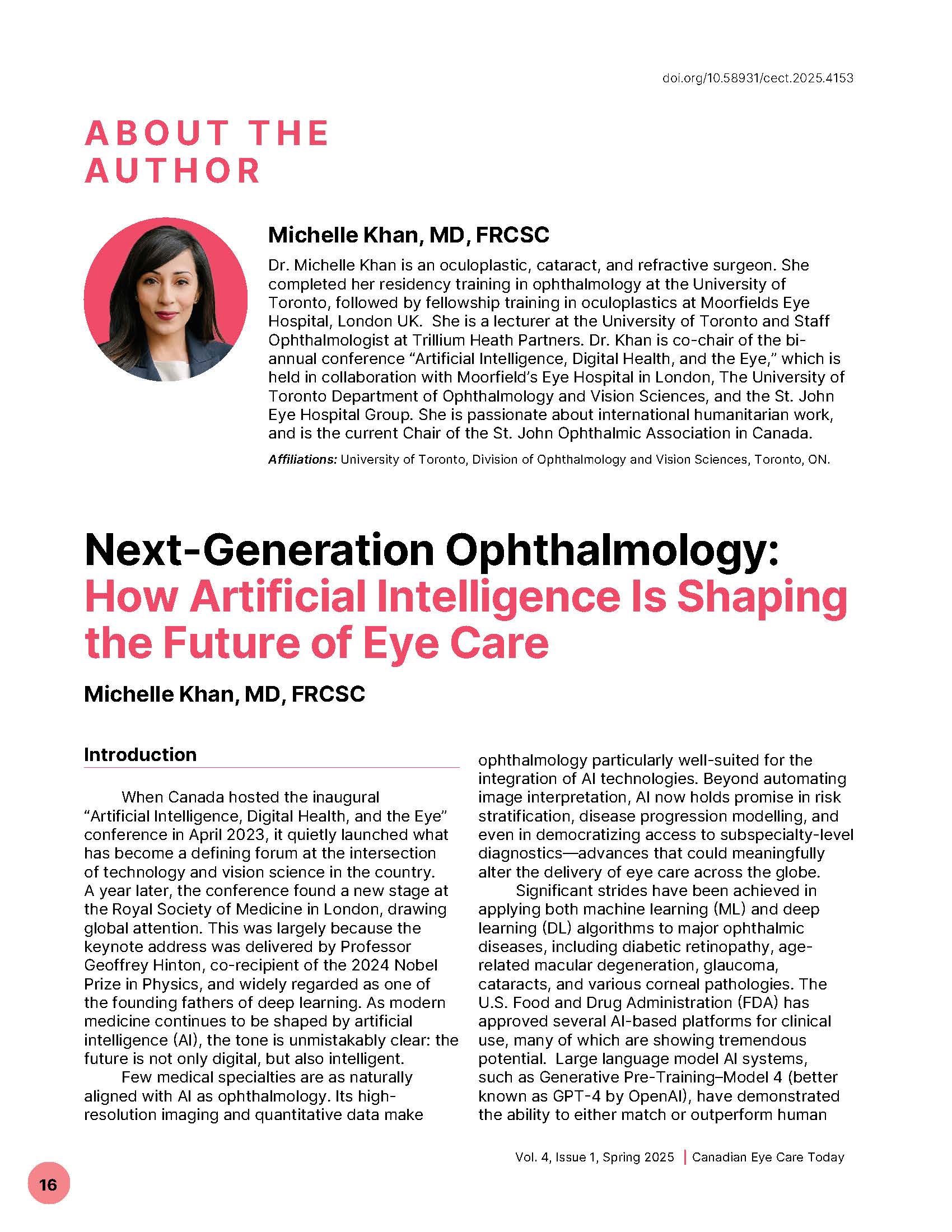Next-Generation Ophthalmology: How Artificial Intelligence Is Shaping the Future of Eye Care
DOI:
https://doi.org/10.58931/cect.2025.4153Abstract
When Canada hosted the inaugural “Artificial Intelligence, Digital Health, and the Eye” conference in April 2023, it quietly launched what has become a defining forum at the intersection of technology and vision science in the country. A year later, the conference found a new stage at the Royal Society of Medicine in London, drawing global attention. This was largely because the keynote address was delivered by Professor Geoffrey Hinton, co-recipient of the 2024 Nobel Prize in Physics, and widely regarded as one of the founding fathers of deep learning. As modern medicine continues to be shaped by artificial intelligence (AI), the tone is unmistakably clear: the future is not only digital, but also intelligent.
Few medical specialties are as naturally aligned with AI as ophthalmology. Its high-resolution imaging and quantitative data make ophthalmology particularly well-suited for the integration of AI technologies. Beyond automating image interpretation, AI now holds promise in risk stratification, disease progression modelling, and even in democratizing access to subspecialty-level diagnostics—advances that could meaningfully alter the delivery of eye care across the globe.
Significant strides have been achieved in applying both machine learning (ML) and deep learning (DL) algorithms to major ophthalmic diseases, including diabetic retinopathy, age-related macular degeneration, glaucoma, cataracts, and various corneal pathologies. The U.S. Food and Drug Administration (FDA) has approved several AI-based platforms for clinical use, many of which are showing tremendous potential. Large language model AI systems, such as Generative Pre-Training–Model 4 (better known as GPT-4 by OpenAI), have demonstrated the ability to either match or outperform human ophthalmologists in diagnosing and treating various ophthalmic diseases.1 This article aims to provide a comprehensive review of the role of AI in ophthalmology, with particular attention to current clinical applications, emerging innovations, and the challenges that lie ahead.
References
Huang AS, Hirabayashi K, Barna L, Parikh D, Pasquale LR. Assessment of a large language model’s responses to questions and cases about glaucoma and retina management. JAMA Ophthalmol. 2024;142(4):371-375. doi:10.1001/jamaophthalmol.2023.6917 DOI: https://doi.org/10.1001/jamaophthalmol.2023.6917
Abràmoff MD, Lavin PT, Birch M, Shah N, Folk JC. Pivotal trial of an autonomous AI-based diagnostic system for detection of diabetic retinopathy in primary care offices. NPJ Digit Med. 2018;1:39. doi:10.1038/s41746-018-0040-6 DOI: https://doi.org/10.1038/s41746-018-0040-6
Hashemian H, Peto T, Ambrósio R, Jr., Lengyel I, Kafieh R, Muhammed Noori A, et al. Application of artificial intelligence in ophthalmology: an updated comprehensive review. J Ophthalmic Vis Res. 2024;19(3):354-367. doi:10.18502/jovr.v19i3.15893 DOI: https://doi.org/10.18502/jovr.v19i3.15893
Charters L. Ophthalmology sees AI-powered impact on cataract and diabetic disease. Ophthalmology Times. 2025;50(1). https://www.ophthalmologytimes.com/view/ophthalmology-sees-ai-powered-impact-on-cataract-and-diabetic-eye-disease
Huang X, Islam MR, Akter S, Ahmed F, Kazami E, Serhan HA, et al. Artificial intelligence in glaucoma: opportunities, challenges, and future directions. Biomed Eng Online. 2023;22(1):126. doi:10.1186/s12938-023-01187-8 DOI: https://doi.org/10.1186/s12938-023-01187-8
Oshika T. Artificial intelligence applications in ophthalmology. JMA J. 2025;8(1):66-75. doi:10.31662/jmaj.2024-0139 DOI: https://doi.org/10.31662/jmaj.2024-0139
Crincoli E, Sacconi R, Querques L, Querques G. Artificial intelligence in age-related macular degeneration: state of the art and recent updates. BMC Ophthalmol. 2024;24(1):121. doi:10.1186/s12886-024-03381-1 DOI: https://doi.org/10.1186/s12886-024-03381-1
Li P, Liu J. Early diagnosis and quantitative analysis of stages in retinopathy of prematurity based on deep convolutional neural networks. Transl Vis Sci Technol. 2022;11(5):17. doi:10.1167/tvst.11.5.17 DOI: https://doi.org/10.1167/tvst.11.5.17
Elsawy A, Eleiwa T, Chase C, Ozcan E, Tolba M, Feuer W, et al. Multidisease deep learning neural network for the diagnosis of corneal diseases. American Journal of Ophthalmology. 2021;226:252-261. doi:https://doi.org/10.1016/j.ajo.2021.01.018 DOI: https://doi.org/10.1016/j.ajo.2021.01.018
Zhao H, Chen X, Liu B, Liu X, Liu Y. Accuracy of refractive outcomes using standard or total keratometry for intraocular lens power formulas in conventional cataract surgery. BMC Ophthalmol. 2023;23(1):346. doi:10.1186/s12886-023-03094-x DOI: https://doi.org/10.1186/s12886-023-03094-x
Triepels R, Segers MHM, Rosen P, Nuijts R, van den Biggelaar F, Henry YP, et al. Development of machine learning models to predict posterior capsule rupture based on the EUREQUO registry. Acta Ophthalmol. 2023;101(6):644-650. doi:10.1111/aos.15648 DOI: https://doi.org/10.1111/aos.15648
Gulshan V, Rajan RP, Widner K, Wu D, Wubbels P, Rhodes T, et al. Performance of a deep-learning algorithm vs manual grading for detecting diabetic retinopathy in India. JAMA Ophthalmol. 2019;137(9):987-993. doi:10.1001/jamaophthalmol.2019.2004 DOI: https://doi.org/10.1001/jamaophthalmol.2019.2004
Liu H, Li R, Zhang Y, Zhang K, Yusufu M, Liu Y, et al. Economic evaluation of combined population-based screening for multiple blindness-causing eye diseases in China: a cost-effectiveness analysis. Lancet Glob Health. 2023;11(3):e456-e465. doi:10.1016/s2214-109x(22)00554-x DOI: https://doi.org/10.1016/S2214-109X(22)00554-X
Teo ZL, Ting DSW. AI telemedicine screening in ophthalmology: health economic considerations. Lancet Glob Health. 2023;11(3):e318-e320. doi:10.1016/s2214-109x(23)00037-2 DOI: https://doi.org/10.1016/S2214-109X(23)00037-2
Ahmed A, Fatani D, Vargas JM, Almutlak M, Bin Helayel H, Fairaq R, et al. Physicians’ perspectives on ChatGPT in ophthalmology: insights on artificial intelligence (AI) integration in clinical practice. Cureus. 2025;17(1):e78069. doi:10.7759/cureus.78069 DOI: https://doi.org/10.7759/cureus.78069

Downloads
Published
How to Cite
Issue
Section
License
Copyright (c) 2025 Canadian Eye Care Today

This work is licensed under a Creative Commons Attribution-NonCommercial-NoDerivatives 4.0 International License.
